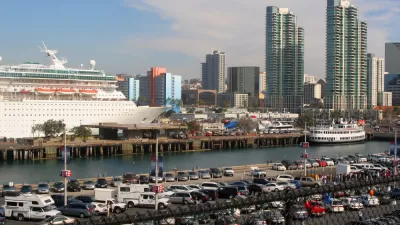The density-enabling mechanisms of the California law Senate Bill 10 are too much for San Diego’s citizen planners.
The San Diego Planning Commission—the citizen advisory group on planning in one of the YIMBYest cities in California—won’t go so far as to eliminate single-family zoning throughout the city.
“San Diego’s Planning Commission unanimously voted against a key part of Mayor Todd Gloria’s housing plan Thursday that would have eliminated single-family zoning in much of the city,” reports Phillip Molnar.
That key part was the Senate Bill 10, a voluntary statewide bill that “[allows] a single-family home to be torn down and replaced with a new structure of up to three stories with up to 10 units in much of the city,” according to Molnar.
Before this setback for the pro-development rends of land use law in the city, San Diego had unbundled parking, removing minimums and setting maximums; expanded transit-oriented development zones; created its own density bonus program; removed commercial parking requirements; and launched an expedited community planning process intended to create more housing options in the city, among other actions.
Though the San Diego City Council could still vote to approve the “Housing Action Plan 2.0,” as proposed by Mayor Todd Gloria in May, Molnar reports that “the mayor’s office confirmed Thursday that it will not be pushing for Senate Bill 10 to be part of the housing package going forward.”
FULL STORY: San Diego Planning Commission votes against Senate Bill 10, major single-family home zone change

Planetizen Federal Action Tracker
A weekly monitor of how Trump’s orders and actions are impacting planners and planning in America.

Congressman Proposes Bill to Rename DC Metro “Trump Train”
The Make Autorail Great Again Act would withhold federal funding to the system until the Washington Metropolitan Area Transit Authority (WMATA), rebrands as the Washington Metropolitan Authority for Greater Access (WMAGA).

The Simple Legislative Tool Transforming Vacant Downtowns
In California, Michigan and Georgia, an easy win is bringing dollars — and delight — back to city centers.

DC Backpedals on Bike Lane Protection, Swaps Barriers for Paint
Citing aesthetic concerns, the city is removing the concrete barriers and flexposts that once separated Arizona Avenue cyclists from motor vehicles.

In These Cities, Most New Housing is Under 441 Square Feet
With loosened restrictions on “micro-housing,” tiny units now make up as much as 66% of newly constructed housing.

Albuquerque’s Microtransit: A Planner’s Answer to Food Access Gaps
New microtransit vans in Albuquerque aim to close food access gaps by linking low-income areas to grocery stores, cutting travel times by 30 percent and offering planners a scalable model for equity-focused transit.
Urban Design for Planners 1: Software Tools
This six-course series explores essential urban design concepts using open source software and equips planners with the tools they need to participate fully in the urban design process.
Planning for Universal Design
Learn the tools for implementing Universal Design in planning regulations.
Smith Gee Studio
City of Charlotte
City of Camden Redevelopment Agency
City of Astoria
Transportation Research & Education Center (TREC) at Portland State University
US High Speed Rail Association
City of Camden Redevelopment Agency
Municipality of Princeton (NJ)





























